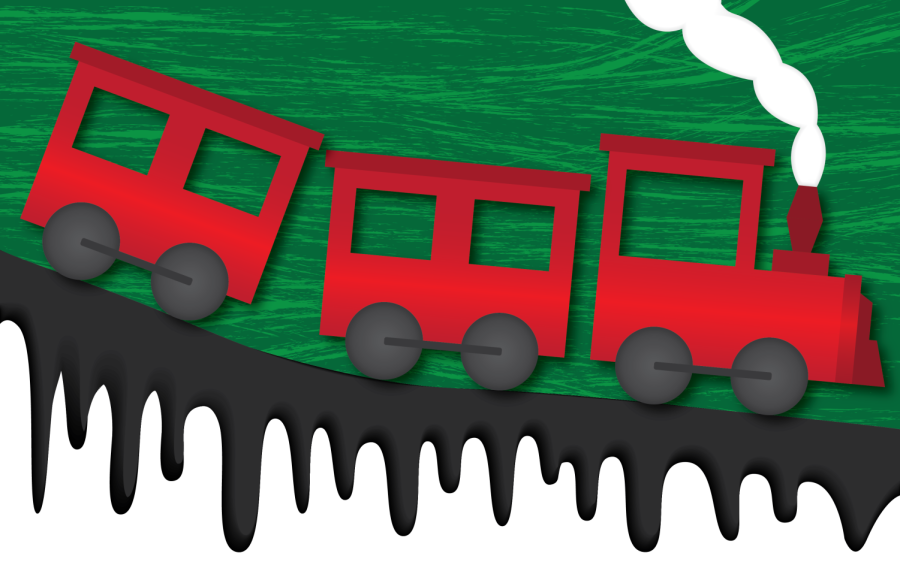The Ohio Freight Train Disaster Threatens Local Community
Last month, the small community of East Palestine, Ohio was home to a freight train crash. The train derailed Feb. 3 due to an overheated bearing on a rail car, causing a fire that smothered the entirety of East Palestine, initiating an evacuation that was further prompted by officials releasing a controlled amount of toxic fumes to neutralize the burning cargo.
The cars on the train carried chemicals and various flammable materials. Vinyl chloride, a severe carcinogen and a toxic, flammable gas, is the biggest concern for investigators. The fire caused by the derailment forced evacuations from both sides of the Ohio-Pennsylvania border, with Governor Mike DeWine warning of a possible explosion.
Three days later, most of the toxic materials from the explosion were diverted and burnt off. However, chemicals released from the explosion including butyl acrylate, ethylhexyl acrylate, ethylene glycol and the previously mentioned vinyl chloride had adverse effects on the environment.
The toxins have contaminated seven and a half miles of stream, killing off 3,500 fish as of Feb. 8. Additionally, many Ohio River tributaries have been found to be polluted. Cameron Mundy, a second-year visual arts major at Seattle University, believes that airborne pollution is also a significant concern.
“I feel like the fumes that have been released from the disaster are creating a really bad air pollution issue and, overall, an extremely unsafe environment,” Mundy said.
The environmental issues don’t stop there, as the toxic chemicals have also polluted the air and soil, prompting over 1,500 residents to evacuate until it is safe to return. The situation is rife with uncertainty as no one knows the actual scale of the disaster and its dangers to public health.
John H. Armstrong, an assistant environmental studies professor at Seattle U, believes the incident is a turning point for rail safety nationwide and that congress should reinforce stronger regulations.
“The disaster has put a national spotlight on rail safety. There are over 1,700 train derailments each year in the U.S., including a good number that have led to hazardous material spills,” Armstrong wrote to The Spectator. “The East Palestine, Ohio disaster shows [the need] to strengthen safety rules and braking systems. Individuals who want to take action can contact their congressional representatives and urge them to support more stringent rail safety rules.”
Concerns about the environmental impact of the disaster continue as many of the harmful compounds are believed to have long-term effects. Reports have found two carcinogenic compounds in the soil and water, and experts fear these compounds may make their way through the soil and into the water table. Ciara Hagen, a second-year environmental science major at Seattle U, also believes this disaster will have long-lasting, negative environmental impacts.
“The effects of this disaster have had drastic immediate effects on the water streams and the air. However, as time goes on, there could possibly be major issues as the toxic chemical can end up harming the vegetation and the soil of East Palestine and surrounding areas,” Hagen said.
Despite the fact that the majority of the disaster has already dissipated, some locals are still experiencing chemical exposure issues. Residents expressed concerns over the prominent smell of chlorine in the air. At the same time, other residents shared pictures of their children with rashes and also reported experiencing migraines, dizziness, sore throats and burning eyes.
Norfolk Southern, the company responsible for the accident, was required to clean and fix the areas affected by the disaster.
This is not the first time railroads have been in the news as of late. Biden signed legislation Dec. 2 that stopped a nationwide railroad strike as tensions between rail companies and workers grew. He claimed that “U.S. Industries would literally shut down“. The bill’s passing did not provide paid sick leave to railroad workers.
With a controversial bill putting railroad workers in a challenging situation and a disaster putting cities in an environmental crisis, the future of America’s railroad industry remains fraught with unanswered questions. While the derailment proved to be a pivotal moment to spur change in railroad safety laws, the environmental effects of the disaster will have long-term negative impacts on the city of East Palestine.











